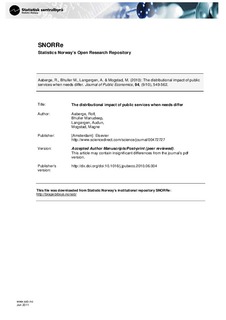| dc.contributor.author | Aaberge, Rolf | |
| dc.contributor.author | Bhuller, Manudeep | |
| dc.contributor.author | Langørgen, Audun | |
| dc.contributor.author | Mogstad, Magne | |
| dc.date.accessioned | 2011-06-09T13:43:02Z | |
| dc.date.available | 2011-06-09T13:43:02Z | |
| dc.date.issued | 2010 | |
| dc.identifier.citation | Journal of Public Economics, Vol. 94 (2010), No 9/10, pp 549-562 | en_US |
| dc.identifier.issn | 1879-2316 | |
| dc.identifier.uri | http://hdl.handle.net/11250/177780 | |
| dc.description | This is the accepted version of a work that was accepted for publication in Journal of Public Economics. Changes resulting from the publishing process, such as peer review, editing, corrections, structural formatting, and other quality control mechanisms may not be reflected in this document. Changes may have been made to this work since it was submitted for publication. A definitive version was subsequently published in Journal of Public Economics, 94, (9/10), 549-562, (October 2010). | en_US |
| dc.description.abstract | Despite a broad consensus on the need to take into account the value of public
services in distributional analysis, there is little reliable evidence on how the inclusion of such
non-cash income actually affects poverty and inequality estimates. In particular, the
equivalence scales applied to cash income are not necessarily appropriate when including noncash
income, because the receipt of public services is likely to be associated with particular
needs. In this paper, we propose a theory-based framework designed to provide a coherent
evaluation of the distributional impact of local public services. The valuation of public services,
identification of target groups, allocation of expenditures to target groups, and adjustment for
differences in needs are derived from a model of local government spending behaviour. Using
Norwegian data from municipal accounts and administrative registers we find that the inclusion
of non-cash income reduces income inequality by about 15 percent and poverty rates by almost
one-third. However, adjusting for differences in needs for public services across population
subgroups offsets about half the inequality reduction and some of the poverty decrease. | en_US |
| dc.language.iso | eng | en_US |
| dc.publisher | [Amsterdam] : Elsevier | en_US |
| dc.subject | Income distribution | en_US |
| dc.subject | Poverty | en_US |
| dc.subject | Public services | en_US |
| dc.subject | Non-cash income | en_US |
| dc.subject | Offentlige tjenester | en_US |
| dc.subject | Equivalence scales | en_US |
| dc.subject | Inntektsfordeling | en_US |
| dc.subject | Fattigdom | en_US |
| dc.subject | Velferd | en_US |
| dc.subject | JEL classification: I30 | en_US |
| dc.subject | JEL classification: D31 | en_US |
| dc.subject | JEL classification: H72 | en_US |
| dc.subject | Scientific article | en_US |
| dc.title | The Distributional impact of public services when needs differ | en_US |
| dc.type | Journal article | en_US |
| dc.type | Peer reviewed | en_US |
| dc.subject.nsi | VDP::Social science: 200::Economics: 210 | en_US |
| dc.source.pagenumber | 549-562 | en_US |
| dc.source.volume | 94 | |
| dc.source.journal | Journal of public economics | |
| dc.source.issue | 9/10 | |
| dc.identifier.doi | https://doi.org/10.1016/j.jpubeco.2010.06.004 | |
